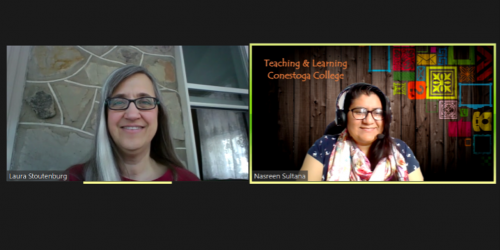Managing Communication in Online Synchronous Classes
The tools of online synchronous classrooms, such as Zoom and MS Teams, provide participants with different ways to communicate and interact. With chat, microphone, and other virtual classroom features, faculty and students can engage in discussion and ask questions of each other.
Faculty can maximize the time spent together with students in the virtual classroom by giving students clear expectations about how they should communicate during class time. As well, by providing some flexibility and different communication options, faculty will help students to meet the different needs and preferences they bring to the online synchronous classroom.
The tips below may assist you in responding to common communication management scenarios that can arise in the online synchronous classroom. Many of these tips may apply to asynchronous learning environments, such an LMS, as well.
Note that in responding to any classroom issues, faculty should always keep in mind Conestoga’s Student Rights and Responsibilities.
Scenario 1: Social “chat talk”
From phone apps to online tech support, texting is a common form of digital communication. Consequently, students may feel more comfortable using the Chat tool for lesson-related comments or questions.
However, if you notice chat appear that is not related to the lesson and may distract other students, here are some suggestions:
Responding to chat talk
- Pause the class to ensure students understand the lesson. Ask students politely to cease chatting and use the “Raise hand” feature to respond to your check-in questions.
- Type in the chat window a message, such as, “Thank you for your enthusiasm for sharing your ideas, but please keep chat related to the class.”
- Inform the class that you will be saving the chat text from the lesson and reviewing it to ensure everyone stays on task.
Managing chat talk
- Use the first 5 minutes of class for social time and to check in with students, or encourage students to arrive 5 minutes early to chat. Let them speak or write in their preferred language.
- Describe how you prefer students use the Chat tool once class begins. Give examples of appropriate and inappropriate use.
- Remind students that they may send chats privately to individuals in the class, but ask that they avoid non-related messages.
- Give breaks in the lesson for students to chat with each other.
Scenario 2: Interruptions or aggressive speaking
Debates and other forms of student-to-student engagement can promote active learning. Turn-taking is an essential skill for discussion in the virtual classroom. Students may need specific instructions for turn-taking in discussion activities, especially if one or two students begin dominating the Chat field or the microphone.
Responding to Interruptions
- Remind everyone that you want as many students as possible to share their ideas.
- Use the “Raise hand” feature to establish a speaking order.
- Switch to an activity that gives more students a chance to speak, such as break out rooms or collaborative document writing.
- Take a 5-minute break and speak with a disruptive student in a breakout room.
- Stay at the end of class to hear students if they have strong opinions.
Preventing interruptions/aggressive speaking
- Create with students a “code of conduct” for turn-taking.
- Post the code of conduct at the beginning of each class or before discussion time.
- Use a virtual “Parking Lot” and take “hot topics” to a different time in the class.
- Provide other asynchronous ways for students to share.
Scenario 3: Oversharing
Some students may want to share personal information, especially if they are feeling anxious about real-time synchronous learning. Just as in the in-person classroom, students can be encouraged to share authentic responses but at the same time maintain the boundaries of personal privacy.
Responding to oversharing
- Thank students for sharing their thoughts and feelings.
- Remind students that the lesson may be recorded, and while it will not be shared beyond the class it is important that students maintain healthy personal boundaries during synchronous class time.
- Take a 5-minute break and speak with a student in a breakout room.
Preventing oversharing
- Do a check-in at the beginning of class that is not recorded. Ask students to share one word that describes their feelings, or ask students to write for 2 minutes how they are feeling on a piece of paper.
- Have students brainstorm about what is appropriate/inappropriate to share about themselves while using technology.
- Offer one-on-one meetings outside of class time, and refer students to Student Advisors.
Scenario 4: “Dead Air”
Silence, or “dead air,” is a normal part of the synchronous classroom experience. Dead air does not mean that students are inattentive: they may be thinking about an answer or finding the right buttons to push to communicate. As well, some students may prefer not to speak in class. Here are some suggestions dealing with dead air in the classroom:
- Model good practices for synchronous communication (smile, use the mic, camera, etc.)
- Ask questions about topics that students care about
- Keep a practice for giving students at least 10 seconds to share a response (and do a silent count down)
- Repeat or rephrase instructions
- Use the raise hand, poll, or chat features
- Be warm and encouraging, and give praise for responses
- Give students multiple ways to reflect (such as silent writing)
- Take frequent breaks
- Adapt or shorten the lesson to the current circumstances
Scenario 5: Unwelcome participants
There have been recent reports of unwelcome participants who come Zoom rooms and screen-share inappropriate/unwanted content. If an unwelcome guest is present in your room, take the following actions:
Before class
- Set up your synchronous class meeting so that participants need permission from the host to share their screens
- Set your meeting to private (password protected), or require that participants register in advance of the meeting
- Take attendance
During/after class
- During a break or pause in class activities, compare the attendance list to the list of Participants
- As host, mute and remove an unwelcome participant immediately
- Contact your Chair and report the incident
Conclusion
It is a good sign if your students feel comfortable communicating in your synchronous classroom, so long as they understand the importance of respecting shared class time as time for learning.
If students are new to synchronous learning, they will appreciate and benefit from clear expectations and instructions on how to communicate appropriately in class. If difficult or unwelcome behaviour in the synchronous classroom persists, you may wish to consider alternate (i.e., asynchronous) lesson delivery options.
Photo by Christina @ wocintechchat.com on Unsplash



